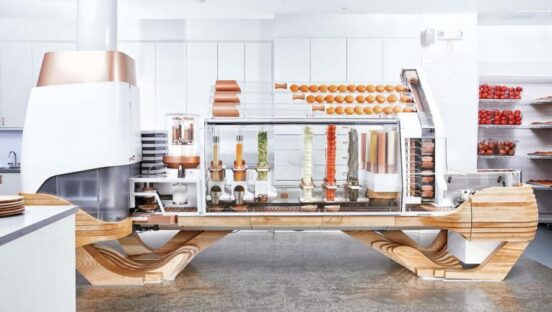When people think of the way AI is currently used in quick service restaurants—such as fast-food chains—they might think of AI-powered voice bots utilized at drive-thrus or AI tools to forecast inventory needs based on demand.
AI-based technology can be an incredibly valuable resource for the restaurant industry when utilized properly. It can make customer experiences more consistent and predictable, minimize human error, and reduce operating costs. Restaurant owners agree, as nearly half of hospitality operators in the U.S. and Canada said they planned to utilize some form of automation technology.
AI is continuing to evolve with new capabilities seemingly by the day. With that in mind, here’s a closer look at some of the ways restaurants will use it in the near future.
Interact with customers using voicebots and chatbots
Restaurants like Taco Bell, Chipotle, and Domino’s, are beginning to implement AI-powered voice and chatbots to take orders, make recommendations, and answer frequently asked questions customers may have. Furthermore, the value of bolstering customer service without having to hire additional staff makes this a cost-efficient, enticing option for restaurants of all shapes and sizes.
ChatGPT, a chatbot based on GPT-3 and GPT-4 technology, can also be trained on a central database with information about local menu availability, opening hours, events, location information and more, resulting in a human-like conversation with a customer. However, the chatbot needs to be set up with accurate and updated information to provide a seamless customer experience.
Optimize delivery services
AI-powered delivery systems are being developed to optimize delivery times and routes. The use of GPS and real-time traffic data enables the delivery system to choose the most efficient and fastest routes, improving delivery times and reducing costs.
However, AI isn’t the only new technology being introduced to improve food delivery: on-demand robotics has recently made an entry in the industry, when UberEats started piloting robots for delivery in certain areas. Such innovations will help not only to create a seamless service while removing some pressure from delivery workers, but also to expand these services to more locations and communities.
Optimize inventory management and demand
The use of AI-powered analytics tools has also revolutionized the way restaurants gather insights about customer behavior and preferences. By analyzing customer data and interactions, these tools can identify trends, patterns, and behaviors that may have otherwise gone unnoticed. For example, data analytics can help restaurants determine the most popular menu items among certain demographic groups or at specific times of day. This information can then be used to adjust the menu, optimize inventory management, and create targeted marketing campaigns that drive sales and increase customer loyalty.
Furthermore, AI can be an invaluable tool in helping restaurants inform pricing strategies and optimize revenue. By analyzing historical demand and sales data, AI can help identify pricing trends and opportunities for promotions or discounts. For example, if a particular menu item is not selling as well as expected, AI can suggest lowering the price to increase demand and avoid waste. Similarly, if a certain item is in high demand, AI can recommend raising the price to optimize for short-term revenue.
Take charge of staffing
AI-powered tools can revolutionize staffing for restaurants, allowing managers to easily manage employee schedules and access important predictive metrics. By automating scheduling and alerting managers in case of absences, AI can free up time and resources for managers to focus on other important tasks. Predictive metrics can also provide insights into busy periods and popular menu items, helping managers make better decisions and optimize staffing and resources during peak times.
The use of AI is not limited to scheduling and staffing. It can also be leveraged to streamline the hiring process, which is particularly important in the restaurant industry where high turnover rates and a labor shortage can make it challenging to find the right employees. AI can automate job postings, screen resumes, and even conduct initial interviews with candidates.
In addition, by focusing on objective qualifications like experience and education, AI can help eliminate bias and ensure that the best candidates are selected. By simplifying the hiring process, restaurant managers can spend more time on other critical tasks, such as customer service and menu development, ultimately leading to a better overall experience for customers.
Visual input and customer recommendation
AI can optimize restaurant photos on business listings to attract customers searching for specific types of cuisine or dishes. Search engines like Google use image recognition technology to identify and classify the content of digital images, so it’s important to make sure your images accurately represent your menu items. Google Lens can also be used by consumers to identify nearby restaurants that have the desired food on the menu.
While there is concern that AI may eventually replace human employees, it is currently being used as a supplemental tool to improve efficiency and increase success. There still needs to be a human element for quality control and overseeing the technology to ensure everything runs smoothly. Although fast-food chains have been the main adopters of AI-powered features and robot tech, restaurants of all sizes can benefit from using AI. As the capabilities of AI continue to develop, it’s likely that restaurants will increasingly rely on it to optimize various aspects of their operations and enhance the overall customer experience.
Jennifer Stevenson is the senior product director of marketing at Uberall.


